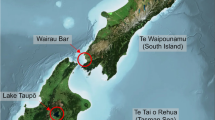Abstract
In 2000, a $7.8 billion plan was signed to help create a feasible and innovative approach to the drying-up problem of the Florida Everglades. The Comprehensive Everglades Restoration Plan (CERP) would be the first time that parties that used to oppose each other regarding this issue will cooperate to reach a common goal. The article describes this intriguing process from a memetics perspective and shows that CERP spread fast because it reconciled different interests.
Similar content being viewed by others
References
Army Corps of Engineers & South Florida Water Management District (1999), Rescuing an Endangered Ecosystem; The Plan to Restore America’s Everglades. Jacksonville/ West Palm Beach, FL: United States Army Corps of Engineers and South Florida Water Management District.
Army Corps of Engineers (2003a), “Why restore the everglades?” 〈www.evergladesplan.org/about/why_restore.cfm〉. Accessed on 9 September 2003.
Army Corps of Engineers (2003b), “The Comprehensive Everglades Restoration Plan (CERP): Development and study goals.” 〈www.evergladesplan.org/about/rest_plan_02.cfm〉. Accessed on 11 September 2003.
Army Corps of Engineers (2003c), “Comprehensive Everglades Restoration Plan Aquifer Storage and Recovery Program.” 〈www.evergladesplan.org/facts_info/sywtkma.cfm〉, Accessed on 15 September 2003.
Army Corps of Engineers (2003d), “Cape Sable Seaside Sparrow.” 〈www.evergladesplan.org/facts_info/sywtkma_sparrow.cfm〉. Accessed on 16 September 2003.
Army Corps of Engineers (2003e), “Recover.” 〈www.evergladesplan.org/pm/recover/recover.cfm〉, Accessed 16 September 2003.
Blackmore, S. (1999), The Meme Machine. Oxford: Oxford University Press.
Bush, J. (2000), “Testimony of Governor Jeb Bush.” United States Senate Committee on the Environment and Public Works Washington, DC. May 11, 2000. 〈www.senate.gov/~epw/bus_0511.htm〉.
Davis, S.M. and Ogden, J.C. (eds.) (1994), Everglades—The Ecosystem and its Restoration: Delray Beach, FL: St. Lucie Press.
Dawkins, R. (1976), The Selfish Gene. Oxford: Oxford University Press.
Dennett, D. (1991), Consciousness Explained. London: Penguin Books.
Environmental Economics Council, National Audubon Society. (1998), “Maximizing water storage for Everglades/South Florida ecosystem restoration and sustainability.” 〈www.audubon.org/campaign/er/library/water-storage.html〉.
Eeten, M.J.G. van and Roe, E (2002), Ecology, Engineering, and Management. Reconciling Ecosystem Rehabilitation and Service Reliability. Oxford: Oxford University Press.
Florida Internet Center for Understanding Sustainability (FICUS) (1999), The Florida Everglades: A Model of Destruction. The University of South Florida. 〈www.ficus.usf.edu/docs/everglade_exhibit/CHAP6-2.HTM〉.
Gore, A. (1992), Earth in the Balance Ecology and the Human Spirit. Boston: Houghton Mifflin.
Governor’s Commission (1999), “Biennial report, maintaining the momentum: in South Florida Econsystem Restoration Task Force.” 〈www.sfrestore.org/documents/biennialreport/01.htm〉. Accessed 11 September 2003.
Gunderson, L. (1999), “Resilience, flexibility and adaptive management: antidotes for spurious certitude?” Conservation Ecology 3 (1). 〈www.consecol.org/Journal/vol3/is1/art7/index.html〉. Accessed on September 19, 2000.
Hull, D. L. (1988), Science as a Process: An Evolutionary Account of the Social and Conceptual Development of Science, University of Chicago Press.
Laland, K. N. and Brown, G. R. (2002), Sense & Nonsense. Evolutionary Perspectives on Human Behaviour. Oxford: Oxford University Press.
Laland, K. N. and Odling-Smee, F.J. (2000), “The Evolution of the Meme.” In Darwinizing Culture: The Status of Memetics of a Science. Oxford: Oxford University Press pp 121–41.
Ogden, J. C. (1999) “Everglades-South Florida assessments.” In Johnson, K.N.; Swanson, F; Herring, M.; and Greene, S. (eds.), Bioregional Assessments: Science at the Crossroads of Management and Policy, Washington, D.C.: Island Press, 169–185.
South Florida Water Management District (2003), “Governing Board.” 〈www.sfwmd.gov/gover/2_govboard.html〉. Accessed on 10 September 2003.
Speel, H.C. (1995) “Memetics: On a conceptual framework for cultural evolution.” Paper presented at the symposium “Einstein meets Magritte,” Free University of Brussels, June.
Washington Post (2002). “The swamp: A rescue plan, bold and uncertain. Scientists, federal officials question project’s benefits for ailing ecosystem.” By Michael Grunwald. First of four articles. 23 June 2002.
Author information
Authors and Affiliations
Additional information
Her research interests are safeguarding public values in privatized utility sectors. Her Ph. D. thesis Bridges and Watersheds was published in 2001 (Aksant, Amsterdam) and analyzes the shifting public private divide in water management under conditions of globalization. She is editor of the journals Bestuurswetenschappen and of Work & Emotion. Her latest book (with de Bruijn et al.) is Creating System Innovations. How Large Scale Transitions Emerge, Taylor and Francis, London (2004).
Rights and permissions
About this article
Cite this article
Dicke, W.M. Tales of a successful memeplex: How the water wars in the everglades were changed into a comprehensive plan. Know Techn Pol 16, 61–76 (2004). https://doi.org/10.1007/s12130-004-1015-2
Issue Date:
DOI: https://doi.org/10.1007/s12130-004-1015-2




